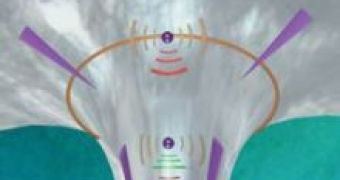Three decades ago, Stephen Hawking made the prediction that black holes are not really black, but that they should emit radiation. He reasoned that if the energy of everything that passes the black holes' horizon (their point of no-return) would indeed accumulate inside the black holes then the total entropy of the universe would decrease. Thus, it would seem that the existence of black holes contradicts the second law of thermodynamics which states the energy tends to dissipate rather than to accumulate. (Entropy is a measure of how dissipated the energy is.)
In order to save the second law of thermodynamics, Hawking said that the black holes needed to emit energy. But just saying that they should emit energy isn't sufficient. How exactly would they do it? By which mechanism could this happen? He argued that black holes' horizon are such small spheres that quantum effects are relevant. According to his theory, a black hole's horizon generates radiation, now called Hawking radiation. Due to this radiation, the black holes eventually evaporate - they gradually diminish their mass releasing the energy back into the universe and eventually turn back into regular objects.
Hawking radiation is too weak to be measured by current technologies. Nonetheless, physicists have come up with an interesting way to simulate this radiation with the help of an analogous sound wave. Certain systems, either solid or liquids, are predicted to behave in such a way that a sound wave would be trapped in them.
One such example involves liquid helium. The sound moves at a certain speed in this liquid. Imagine now that a portion of the liquid moves at supersonic speeds. Any sound produced inside this portion of liquid could not escape into the outside. "A swimmer in this supersonic region could cry out for help, but the sound waves would never escape to the stationary region," Michael Schirber wrote. In the image it is shown that once an object falls past a black hole's event horizon (gold curve), it can no longer send signals out in all directions, but just inside the black hole.
When one studies the equations describing such a supersonic sound trap one discovers that, like a black hole's horizon, it should also emit radiation. The radiation would be emitted by the edges of the supersonic region. One needs to use such an exotic liquid like helium for simulating the quantum mechanical aspects of the Hawking radiation. The radiation emitted by edges of the supersonic sound trap would come in particles of sound, called phonons.
Although this appears to be more amenable to experiments than the actual Hawking radiation, still no one has yet succeeded in creating a supersonic trap in the lab. The main difficulty is that it is hard to prevent turbulence from occurring at such high speeds.
The experimental set up for detecting the radiation could be fairly simple. One needs a tube that gradually gets narrower. Because the quantity of liquid per second that passes through is the same in any portion of the tube, in the narrower portions, the liquid has to move faster. So, if one gradually increases the speed with which one pumps the liquid in the tube (from above), one would eventually have the liquid in the lower portions of the tube moving supersonically. An observer upstream should then hear the Hawking-like sound radiation coming from the supersonic sound trap.
The problem is only how to prevent turbulence. Theoretically, turbulence wouldn't appear if the tube was frictionless. Researchers from Astrophysics Institute of Andaluc?a in Granada, Spain, have now discovered that the sound analogous of Hawking radiation might be easier to create than previously thought.
When Carlos Barcel? and his colleagues modeled the tube described above, assuming that it was frictionless, they found that the Hawking-like radiation would appear before supersonic speeds were reached - thus, before the sound trap appeared. "It was surprising. I was expecting to see no radiation," says co-author Stefano Liberati of the International School of Advanced Studies in Trieste, Italy.
Besides the fact that this means the experiments should be easier to conduct, this discovery also has implications about the real black holes. The discovery indicates that objects that are not (yet) black holes can still emit Hawking radiation. When a star collapses toward becoming a black hole it begins to be like a black hole before actually being a hole.

 14 DAY TRIAL //
14 DAY TRIAL // 
